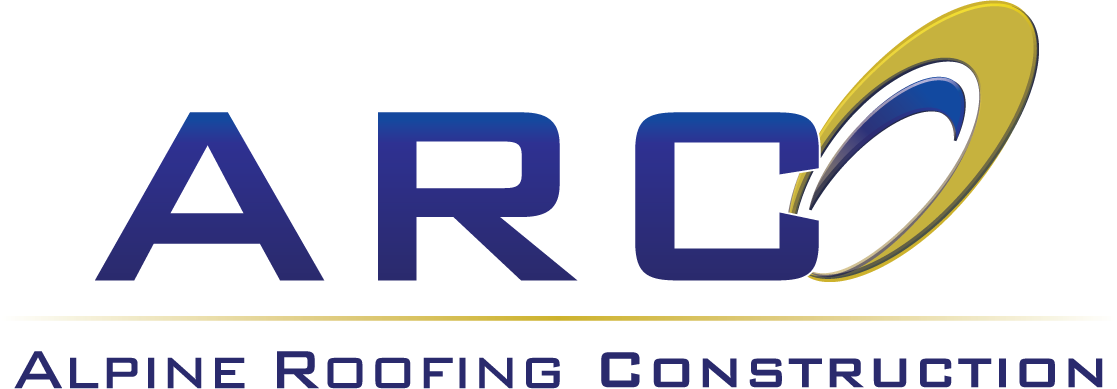When considering a new roofing system, there are many factors to consider. Even if you have decided on a metal roof, there are still many considerations. The Alpine Roofing Construction experts are here to help. We walk you through the roofing selection and installation process to ensure you can make educated and realistic decisions about your roofing project. Call us today to speak with a roofing expert.
Commercial Metal Roofing

Alpine Sheet Metal Systems is a Certified Installer of multiple top metal roofing manufacturers, which helps ensure that you get the best service, highest-quality installation, and longest warranty available. Our experts work with you from start to finish to help guarantee that your sheet metal roofing system is done right the first time. Call us today to talk about all of your metal roofing options.
Galvanized Steel
Galvanized steel roofing refers to roofing panels or sheets made from steel coated with a layer of zinc through a process called galvanization. Galvanization involves applying a protective zinc coating to steel to enhance its durability and resistance to corrosion. Roofing experts everywhere use this type of roofing material in both residential and commercial construction due to its strength, longevity, and protective properties.
The galvanization process involves immersing the steel in a bath of molten zinc or applying a zinc coating through an electrochemical process. The zinc coating forms a metallurgical bond with the underlying steel, creating a protective barrier that shields the steel from exposure to moisture, oxygen, and other corrosive elements.
Galvanized steel roofing panels typically have a lifespan of around 20 to 30 years before they may require significant maintenance or replacement. Regular maintenance and addressing any issues promptly can extend their lifespan.
Galvalume Steel
Galvalume steel roofing is a type of roofing material made from steel that is coated with a combination of aluminum, zinc, and silicon. The term “Galvalume” is a trademark of the Bethlehem Steel Corporation, now owned by ArcelorMittal, and is used to describe this specific type of coated steel.
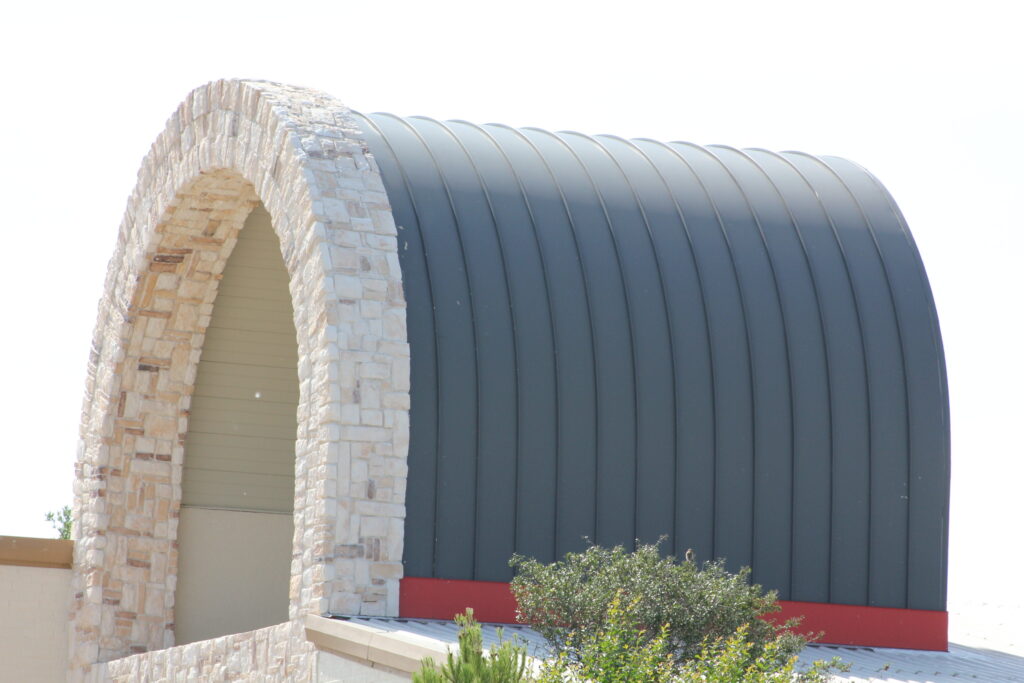
Galvalume roofing combines the corrosion-resistant properties of both aluminum and zinc to create a roofing material that offers enhanced durability and longevity. The process of creating Galvalume steel involves applying a coating of aluminum-zinc alloy to the surface of the steel through a continuous hot-dip process.
Galvalume steel roofing can last around 30 to 50 years or more with proper maintenance.
Aluminum Roofing
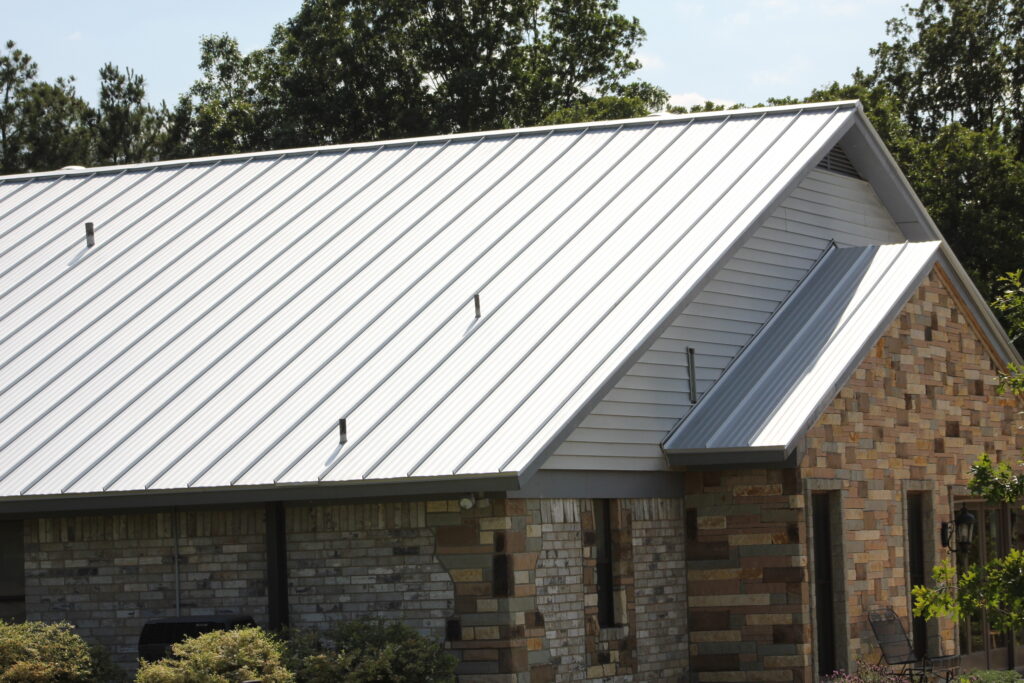
Aluminum roofing is known for its durability, longevity, and versatility, making it a popular choice for various residential, commercial, and industrial applications. There are several types of aluminum roofing systems available, each with its own set of benefits and characteristics.
Aluminum roofing panels are highly corrosion-resistant and can last 40 years or more. Roofers often choose aluminum for coastal and marine environments due to their resistance to saltwater exposure.
Copper Roofing
Copper roofing is known for its beauty and exceptional durability. A properly installed copper roof can last well over 50 years and can even extend to 100 years or more with minimal maintenance.
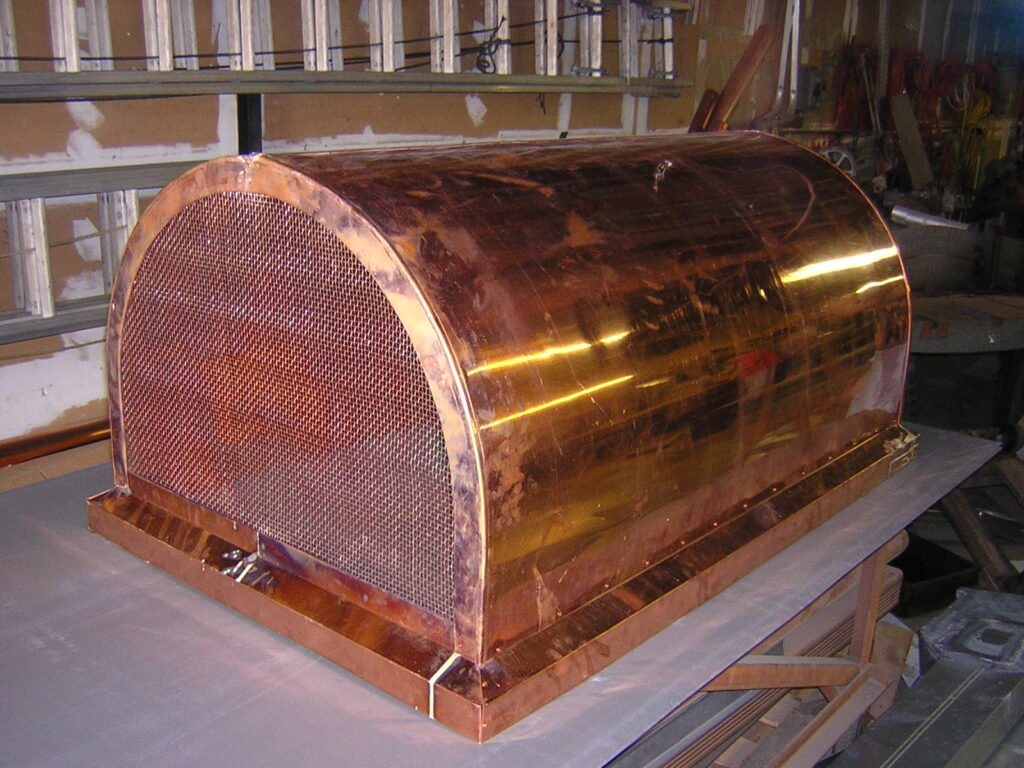
Zinc: Zinc roofing is known for its self-healing properties and resistance to corrosion. Zinc roofs can last around 50 to 100 years or more, depending on the thickness of the zinc material.
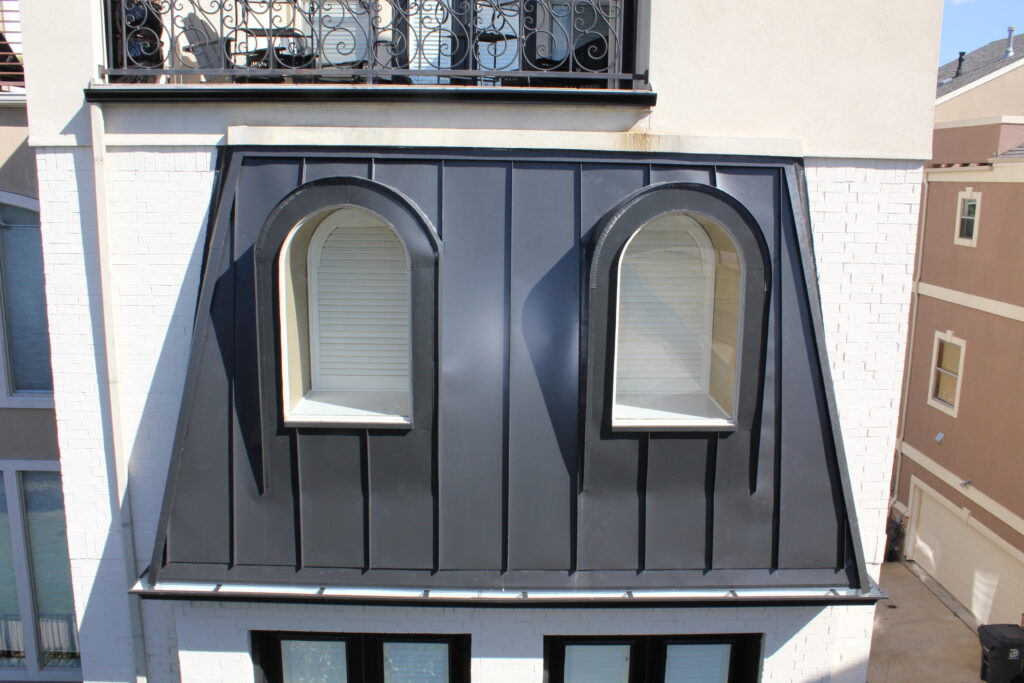
Painted or Coated Metal: Commercial metal roofing panels are often coated with paint or other protective coatings to enhance their durability and appearance. The lifespan of painted or coated metal roofing can vary widely based on the quality of the coating and the local climate. Generally, quality coatings can extend the lifespan by an additional 10 to 20 years.
It’s important to note that regular maintenance plays a significant role in prolonging the lifespan of a commercial metal roofing system. Inspecting the roof, addressing minor issues promptly, and conducting routine cleaning can help prevent larger problems from developing.
Minimal Leaks: Proper installation of metal roofing, along with the absence of seams or joints on most panels, can reduce the risk of leaks and water infiltration.
When considering a commercial metal roofing system, it’s advisable to work with experienced roofing professionals who can recommend the right type of metal for your specific needs and provide proper installation and maintenance guidelines. Additionally, consulting the manufacturer’s warranty information can give you an idea of the expected lifespan of the roofing material.
Residential Metal Roofing
Residential metal roofing offers a wide range of benefits that make it a popular and advantageous choice for homeowners. Here are some of the key benefits of residential metal roofing:
- Longevity: Metal roofing has a significantly longer lifespan compared to many other roofing materials. Depending on the type of metal used, proper installation, and maintenance, a metal roof can last anywhere from 40 to over 100 years
- Energy Efficiency: Metal roofing can reflect a significant portion of the sun’s rays, reducing heat absorption and helping to keep the home cooler. This can result in lower energy bills, especially during hot summers.
- Fire Resistance: Metal is non-combustible, which can help protect your home from potential fire hazards, particularly in areas prone to wildfires.
- Resale Value: A metal roof can add to the resale value of a home due to its durability and energy-saving benefits, making it an attractive feature for potential buyers.
- Low Slope Compatibility: Metal roofing can be installed on roofs with lower slopes, which might not be suitable for other roofing materials.
- Minimal Leaks: Proper installation of metal roofing, along with the absence of seams or joints on most panels, can reduce the risk of leaks and water infiltration.
- Durability: Metal roofs are highly durable and can withstand various weather conditions, including heavy rain, snow, hail, wind, and even fire. They are also resistant to pests and mildew.
- Low Maintenance: Metal roofs require minimal maintenance compared to other roofing materials. They do not rot, warp, or crack, and they are less prone to leaking.
- Aesthetic Options: Metal roofing comes in a variety of styles, colors, and finishes, allowing homeowners to choose a look that complements their home’s architecture and personal style.
- Lightweight: Metal roofing is relatively lightweight compared to other roofing materials, which can reduce the strain on the structure of the house and may eliminate the need for additional structural support.
- Environmentally Friendly: Many metal roofing materials are made from recycled materials, and at the end of their long lifespan, they can be fully recycled. Additionally, their energy-efficient properties can contribute to a lower carbon footprint.
- Weather Resistance: Metal roofing is designed to withstand extreme weather conditions, including heavy snow, high winds, and hail, making it a reliable option for homes in various climates.
While residential metal roofing offers numerous benefits, it’s essential to consider factors such as your location, budget, and aesthetic preferences when making a roofing decision. Working with experienced roofing professionals can help you choose the right type of metal roofing for your home and ensure proper installation for optimal performance and longevity.
Standing Seam Metal Roofing
Standing seam metal roofing stands as a preferred choice for both residential and commercial buildings, offering a multitude of benefits.
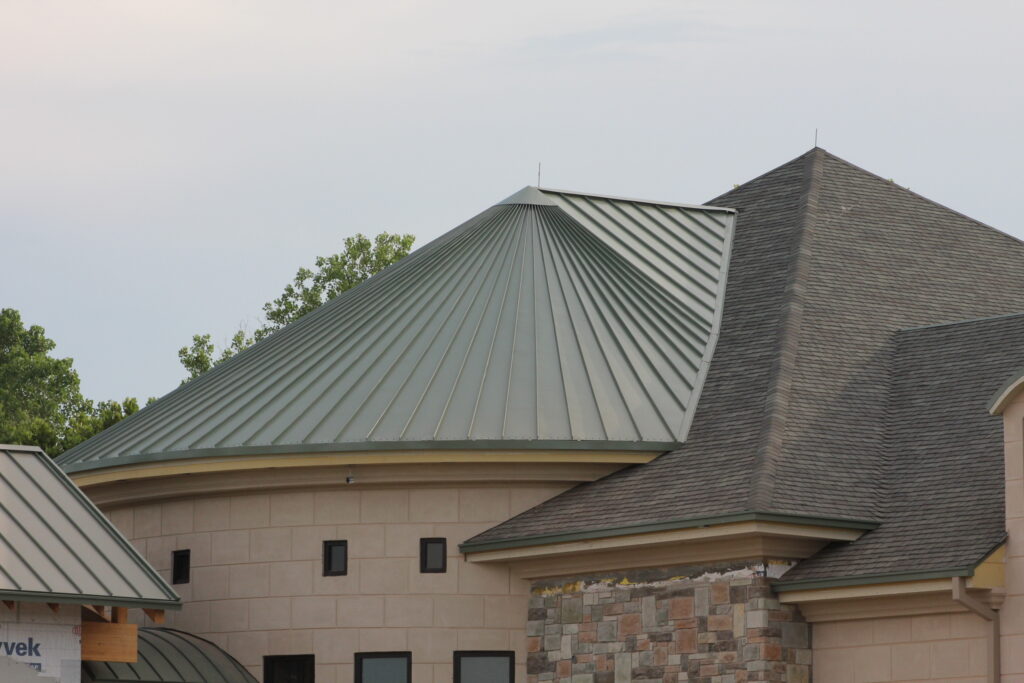
Durability: Highly resilient, it can last for decades, often exceeding 50 years with proper installation and maintenance. It withstands rain, snow, hail, wind, and UV rays.
Weather Resistance: Interlocking panels and concealed fasteners provide exceptional weather resistance, guarding against water, snow, and debris.
Minimal Maintenance: This roofing type requires little upkeep, as it doesn’t rot, warp, crack, or fade, reducing the need for repairs.
Energy Efficiency: Reflecting sunlight and radiating heat keeps buildings cooler during hot weather, leading to reduced cooling costs.
Fire Resistance: As a non-combustible material, it offers excellent fire resistance, enhancing structural protection.
Longevity: With a long lifespan, it proves cost-effective in the long run, reducing replacement and maintenance costs over time.Versatility: It suits diverse buildings, including residential homes, commercial structures, and agricultural buildings.
Aesthetic Appeal: Sporting a sleek, modern look, it comes in various colors, finishes, and profiles to match architectural styles.
Quick Installation: The snap-together or mechanical seaming installation process is relatively fast, minimizing labor costs and disruption.
Low Maintenance Requirements: Its durability and weather resistance translate into minimal maintenance compared to other materials.
Resale Value: The durability contributes to increased property value, appealing to potential buyers.
Recyclability: Metal roofing materials are often made from recycled content and can be fully recycled at the end of their lifespan, making them an eco-friendly choice.
Design Flexibility: Suitable for roofs with different slopes and shapes, it accommodates a wide range of architectural designs.
Snow Shedding: The raised seams help prevent snow buildup and potential structural damage.
Note that the benefits of standing seam metal roofing may vary depending on factors like the type of metal used, installation quality, and local climate. Relying on experienced roofing professionals ensures optimal results.
Metal Tile Roofing
Metal tile roofing combines the durability of metal with the aesthetics of traditional materials. It replicates the appearance of clay or concrete tiles and offers the advantages of metal, including longevity, weather resistance, and energy efficiency.
Comprising metal panels shaped like individual tiles, this system provides a seamless, water-resistant roof.
Simulated Metal Slate Roofing
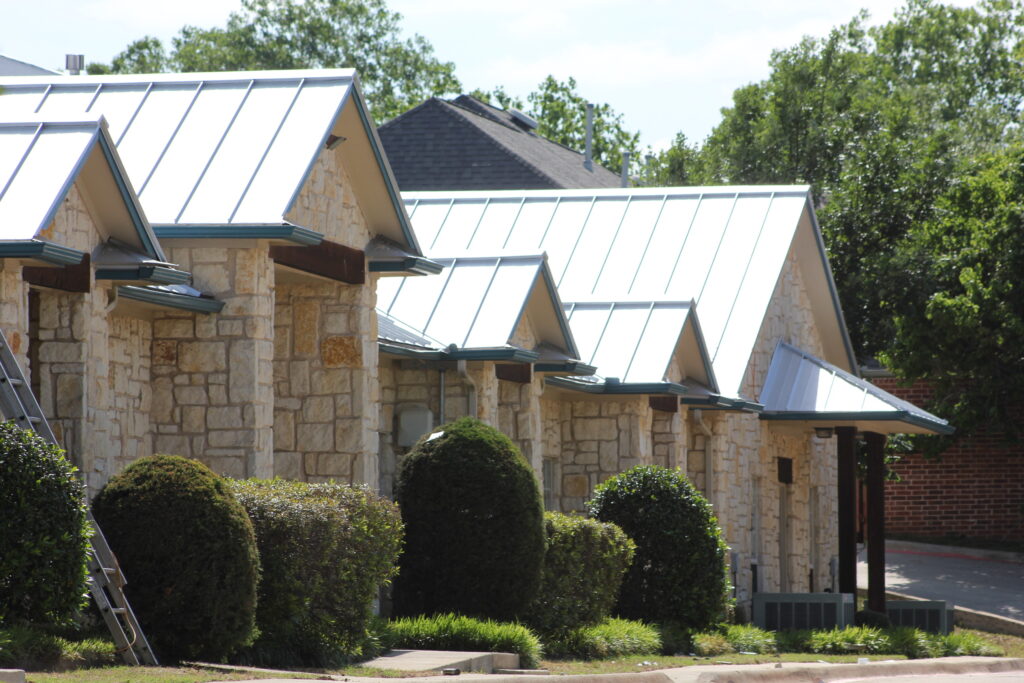
Simulated metal slate roofing mimics natural slate using metal materials. It combines the elegance of slate with the benefits of metal.
Aesthetic Appeal: Captures the timeless beauty of natural slate, enhancing a building’s appearance.
Low Maintenance: Requires minimal upkeep and is less prone to cracking, chipping, and breakage.
Lightweight: Significantly lighter than natural slate, it reduces the structural load and simplifies installation.
Versatility: Available in various colors and profiles, it can be customized to match different architectural styles.
Longevity: Metal slate roofing systems can last for several decades, often outperforming traditional roofing materials.
Durability: Metal materials resist weathering, impact, and pests, resulting in a longer lifespan compared to traditional slate. Read More
Energy Efficiency: Reflects sunlight, reducing heat absorption and cooling costs.
Sustainability: Can be recycled at the end of its life, contributing to environmental sustainability.
